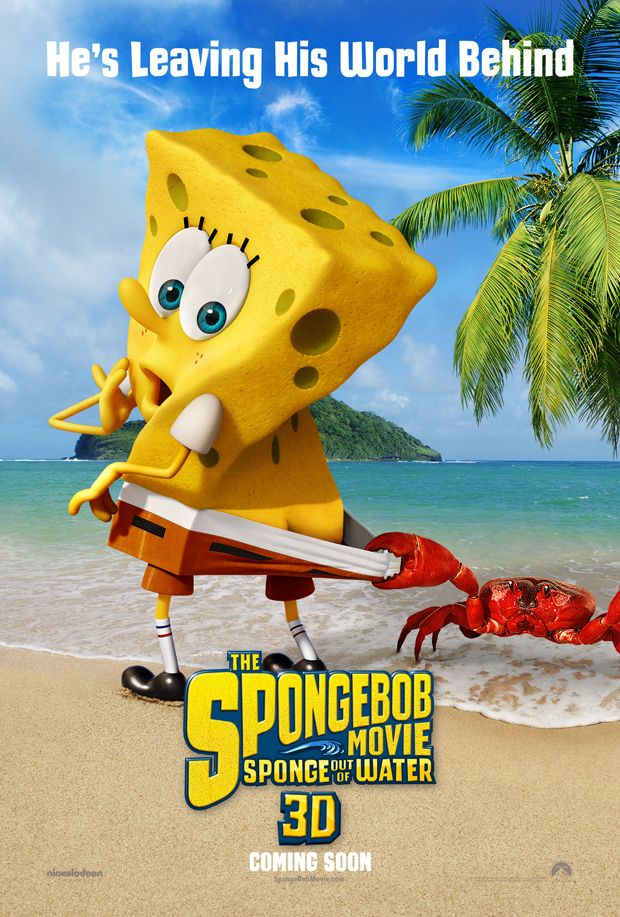With The SpongeBob Movie: Sponge Out of Water hitting theater screens this weekend, we at Animation Magazine received this great list from veteran SpongeBob animator Tuck Tucker. Now an animation professor at Longwood University in Virginia, Tucker was kind enough to share some SpongeBob life lessons:
1. Shows are sometimes better when the animators write the stories.
Ren & Stimpy, which debuted in 1991, almost ushered in a new era in television animation. The show was released just two years after The Simpsons hit the airwaves, and Ren creator John Kricfalusi dusted off an old model that hadn’t been used in television since the days of Merry Melodies: storyboard-driven plot. In a storyboard-driven show, the animators start with a blank canvas — literally. They come up with a plot and storyboard out the episode — and the art drives the show. Animators pitch the storyboard to producers, who send approved episodes to further development with writing teams.
“Ren changed it all. Even though full-length movies like Who Framed Roger Rabbit? and The Little Mermaid were board driven, it wasn’t used in television very much,” says Tucker. “Even with The Simpsons, which is a very good show, writers drove all of the plot, and animators had to work within a script. The advantage of letting animators be the driving force behind the show is that you put art at the center of the show, and quite often something spectacular arises.”
The show Tucker spent the longest stretch of his career working on, SpongeBob SquarePants, is storyboard-driven, and Tucker credits its popularity to the artistic license given to the animators.
2. It’s good to be a little naughty sometimes.
Think back. What are your favorite animated series? Is it The Simpsons? Powerpuff Girls? King of the Hill? Adventure Time? Even SpongeBob?
There’s a common denominator in all of those shows—they are all a bit naughty at times. That’s important — and intentional — says Tucker. “The best shows are ones that are not only relevant but are humorous to people of all ages,” he says. “Adding in a touch of blue to the jokes gives it a bit of sophistication that makes the show last longer. And, to be honest, sometimes it’s just funnier material.”
3. Working fast produces fresh results
We all get stuck in a rut in our jobs from time to time. It’s no different with animators, many of whom spent their formative years filling up notepads with endless doodles and sketches. So how to break out of a rut when you’re trying to come up with a story?
“Work fast,” says Tucker. “Work really fast. Work so fast your brain can’t think about what you are doing — and then you’ll come up with something that you hadn’t even considered before.”
4. When stuck on a story, try beginning at the end and working backward.
“You may think this is trite, and it’s advice given out all over the place, but working backward really works,” says Tucker. “When working on SpongeBob, as I sat down to storyboard out a potential episode, there were more than a few times I just stared at a blank sheet of paper for hours, trying to think of a place to start. But if you don’t know where you’re going, you’ll never know where to begin.”
5. Draw your best and biggest ideas first.
Have you ever sat down to write a short story or paint a picture or draw a cartoon — and lost your way very quickly? It’s easy to get bogged down in the weeds and never get to the payoff. That’s why Tucker says to pull out the machete, chop down all the weeds and start with the biggest idea you have.
“Your biggest idea, the thing you are most excited about, is the thing that’s going to inject energy throughout the project,” he said. “Don’t waste time at the beginning trying to get there, just be there. And once you’ve drawn what you’re most excited about, draw the next thing that seems exciting. Soon enough, you’ll have the dots in place, and all you have to do is connect them. That’s really letting the art drive the story.”
6. Find a mentor.
Every great story has a mentor — the person who helps clarify the hero’s purpose and gives sound advice that carries them through the hardest times. Gandalf, Professor Dumbledore, Yoda, Mr. Miyagi, the list goes on and on.
Likewise, all great storytellers have a mentor — even if he or she is a figment of their imagination.
“I always used Chuck Jones, the animator of the old Looney Tunes, as silly as that may sound,” says Tucker. “When I’d get into a pickle, I’d always ask myself, ‘What would Chuck do in a situation like this?’ And after I ran through the ACME dynamite option — always a good fallback — just pondering that question really helped solve a lot of problems.”
The point is, you aren’t going to get anywhere without some help. And a mentor — real or imagined — can help you iron out some difficult plot lines or help you find your artistic voice when it all seems lost. “If I can play that role for students,” says Tucker, “that’s one of the most rewarding things I’ll do in my life. There have been so many people who have helped and steered me in the right direction, passing that gift along is a privilege. Even if I just tell them to throw in some dynamite and see what happens.”









Great suggestions. This could help me as a scriptwriter for animated films. 🙂
Super storyboarding tips — Especially points #3 thru #5! As for his comments about having a mentor, back when we were boarding on Hey Arnold, Tuck was one of the people that took my skull-full-of-mush and helped turn me into a storyboard artist. Thanks Tuck!
I couldn’t disagree with the first 3 more.
1. Devaluing professional writers in animation is ludicrous and the growing trend is frustrating. Yes, an animator who is a great storyteller can draw a story, but saying this is always the best answer ignores more plot-based shows, saying that cartoons can only be about visual gags and comedy.
2. “Blue” jokes are only “Sophisticated” according to adults who are afraid to admit they enjoy a good story, regardless of its target audience, unless they can point something out that makes it less of a “kids show.” Saying it makes a show better is pandering to a tiring stigma in the American animation industry.
3. Yeah, freewriting and doodling are great and all, but good storytelling needs time to simmer and be at its best.
Then again, I haven’t enjoyed Spongebob in years and suffer second-hand embarrassment for Nickelodeon that they can’t create any new content so they keep trying to fuel a show that needs to be given a rest, so yeah.
Well, I have to take issue with your bitter assessment there, Netbug.
The first point in the article says “Sometimes” and “Often”. What it doesn’t say is your criticism that the author claims “this is always the best answer”. And as a sometimes and often statement, #1 is an obvious truth – some animation IS better served by being storyboard driven.
I enjoy shows that are clever on multiple levels. A good story for kids that also plays at a second level just makes it that much more fun for me as an adult. And it is fun for the writers as well. I am not embarrassed because I enjoy cartoons that little kids also like, but I can also take pleasure in the kind of naughtiness that slips past little kids. And those same shows take on a different pleasure for the kids when they grow up and discover all of the naughtiness they didn’t understand when they first enjoyed the show.
And while I am the type of writer that loves to polish and polish, there is simply no denying that for some people working fast really can produce great results. In Keith Johnstone’s classic book, Impro, he points out that our first ideas are often our most creative, but we have a tendency not to trust them because they came so easily.
These are some very appropriate words of wisdom, especially with my current workload in trying to draw out these comics for a client. I will try and think like my heroes, like in number 6, to come up with some solutions to my current problems.
Great post 🙂
Great tips all of them. I also think about what the great animators at WB back in the day would’ve done. Or Hanna Barbera or even Disney. (Depending on the product I need to churn out. ) When I sit done at stare at a piece of paper, or a blank monitor these days, I re-read the script. I read pretty fast, but I also try to act out the characters while I’m reading. I give them voices and use sound effects (in my head). I may look a little goofy, (no pun) but my ideas start rolling. Sometimes my hand can’t catch up. Good stuff here, thank you.